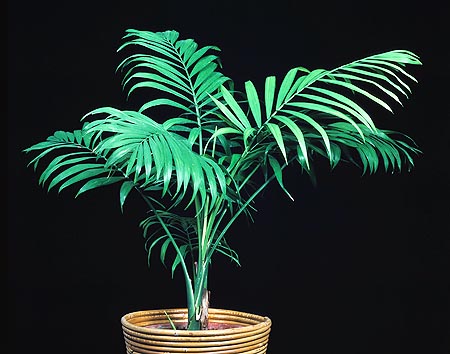Family : Arecaceae

Text © Pietro Puccio

English translation by Mario Beltramini

One of the most utilized palms for indoor decoration © Giuseppe Mazza
The name of the genus comes from the Greek “chamai” = “close to the ground”, and, for extension, “low”, and “dorea” = “donation, gift”; maybe with reference to the low posture of the plant. Wildenow, who set up the genus in 1806, did not mention explicitly the precise meaning of the name. The one of the species, comes from the Latin “elegans”.
In the countries of origin, it is known as pacaya, xate, palmilla, palma fina; in the English-speaking countries, as good-luck palm, parlour palm, collinia.
It presents a solitary stem, tall even more than two metres, and a diameter from 1 to 1,5 cm, upright, or curved, particularly in the old specimen, of green colour, with well evident rings, marking the trace of the foliar wounds. The leaves are pennate, long from to 30 cm to about 80, with dark green pinnules, of a rather chartaceous appearance, long up to 30 cm.
Dioecious palm (each individual either carries male or female flowers only), it presents erect inflorescences with a peduncle green coloured when blossoming, and orange when fruiting. The flowers are small, 3-4 mm, and yellow coloured; the fruits are globous, of about 6 mm of diameter, black coloured. It reproduces by seed, which germinates in 3-4 months.
Introduced in cultivation during the second half of the nineteenth century, has become immediately very popular due to its adaptability to poorly illuminated locations, and the easiness of cultivation. Usually put in commerce along with other plants in the same pot, due to a thicker appearance, it has contended for long time with the Howea forsteriana (kentia), the supremacy as plant for indoor decoration, only in the most recent years the supply in this sector has started to diversify. As outdoor plant, it can be cultivated in the tropical, subtropical and warm temperate zones, in a shaded position, on soils rich of organic substance and maintained humid; it resists to temperature as low as -4°C.
Synonyms: Neanthe bella O.F. Cook (1937); Neanthe elegans (Mart.) O.F.Cook (1937); Chamaedorea deppeana Klotzsch, (1852); Chamaedorea helleriana Klotzsch, (1852); Chamaedorea humilis (Liebm. ex Oerst.) Mart., (1849); Chamaedorea pulchella Linden, (1887); Collinia deppeana Klotzsch, Allg.Gartenzeitung 20 : 362 (1852); Collinia elegans (Mart.) Liebm. ex Oerst. (1846); Collinia humilis Liebm. ex Oerst. (1846); Nunnezharia humilis (Liebm. ex Oerst.) Kuntze, (1891).
→ For general notions about ARECACEAE please click here.
